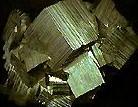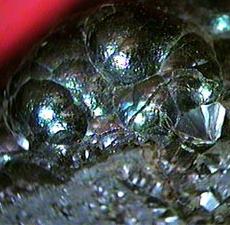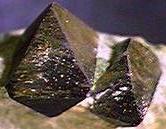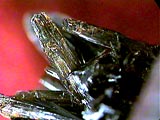
PERSONAL DETAILS:
MAIN PAGE:
SPOT PRICES:
DEPOSIT MODELS:
IDENTIFYING MINERALS:
CARBONATES:
HALIDES
NATIVE
ELEMENTS:
OXIDES:
SILICATES:
SULPHATES:
SULPHIDES:
LINKS:
SIGN
GUESTBOOK:
View Guestbook:
View Old Guestbook:


Cassiterite: Tin Oxide (copyright theimage.com)
from dark brown to black with a a high degree of sparkle (adamantine). Hardness ranges from
6-7 with a prismatic cleavage present. Cassiterite is common in high temperature hydrothermal
veins with quartz and within or near to granites (pegmatites and greisens (altered granite)). World
class deposits have been found in England (Cornwall), Malaysia, Russia and the USA.

Hematite: Iron Oxide (copyright theimage.com)
Hematite crystals can be tabular or rhombohedral arranged in a rose like form (iron roses),
or more commonly they are mammilated or botryoidal. Hardness ranges from 5-6. The most
diagnostic feature of hematite is its streak which is always a dark red to red brown. Hematite
is a common accessory mineral of many igneous rocks because it forms under oxidising conditions. Also present in pegmatites, hydrothermal veins and sedimentary rocks where it forms through the diagenesis of limonite often as ooliths or cement. World class deposits in USA (Lake Superior), Canada (Quebec), Venezuela and Brazil.

Magnetite: Iron Oxide (copyright theimage.com)
perfect octahedrons or less commonly dodecahedrans, all with striated faces. Hardness ranges
from 5.5-6.5 with no cleavage. One other important charactersitic of magnetite is that it is strongly magnetic. This mineral is common in a wide variety of rock types. In igneous mafic and ultramafic extrusives where it is present as an accessory mineral, in metamorphic rocks where it forms by the reduction of hematite and in detrital sediments and iron formations. World class deposits are found
in Sweden (Kiruna district), South Africa (Bushveld Complex), USA (Utah), former USSR (Ural mountains).

Goethite: Iron Hydroxide (copyright theimage.com)
adamantine when crystalline but silky when massive. Crystals are more commonly tabular,
acicular, botryoidal or massive in habit, prismatic crystals do exist but these are rare. Goethite has
one perfect cleavage and a hardness of between 5-5.5. This mineral is an important constituent of limonite which is a rock that forms under oxidising conditions by replacing iron bearing minerals.
World class deposits found in Cuba, Westphalia (Germany), Cornwall (England) and Labrador (Canada).

Cuprite: Copper Oxide (copyright theimage.com)

Rutile: Titanium Oxide (copyright theimage.com)
It has not been my intention to break any copyright rules, however, if I have stepped on someones toes, please Email me and I will be more than happy to rectify the situation.
